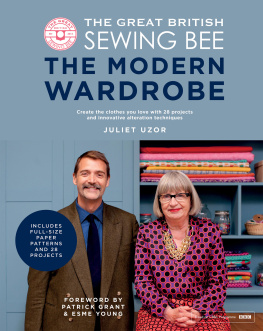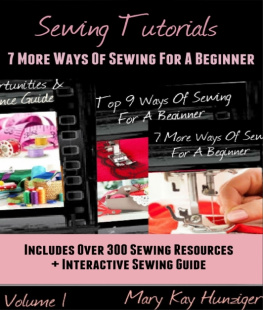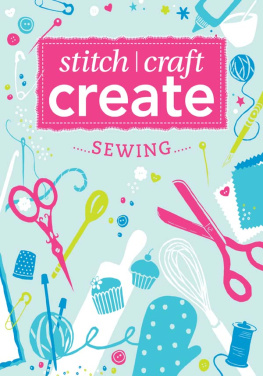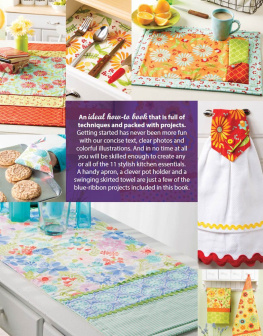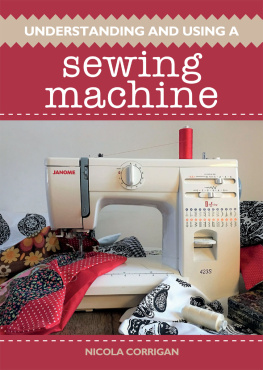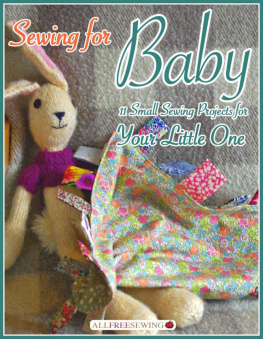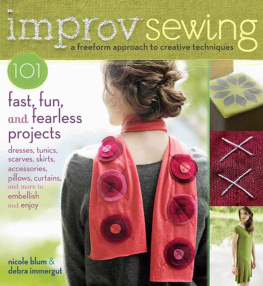
Text copyright 2011 by Ellen Luckett Baker.
Photographs copyright 2011 by Laura Malek.
Illustrations copyright 2011 by Ellen Luckett Baker.
All rights reserved. No part of this book may be reproduced in any form without written permission from the publisher.
ISBN 978-1-4521-0481-2
The Library of Congress has previously cataloged this title under ISBN 978-0-8118-7649-0
Designed by Vivien Sung
Typesetting by Melinda Macfadden
Photo styling by Ellen Luckett Baker
Chronicle Books LLC
680 Second Street
San Francisco, CA 94107
www.chroniclebooks.com

Contents
SPECIAL BONUS PROJECT
Available online! Visit
www.chroniclebooks.com/123Sew
for the instructions
INTRODUCTION
I started sewing eight years ago. Before then I never considered myself a crafty person, though I always had an interest in art and design. The first thing I made was a pumpkin costume for my older daughters first Halloween. I cant say I enjoyed every step of the process, but I do know that I was pleased with the end resultthe satisfaction that comes from a tangible accomplishment. For me, sewing has always been about proving to myself that I could do it, even when I didnt know how. With that first project, I figured it out and never looked back.
After I started sewing, my mother and her generous friend Marjorie lent me their embroidery machines so I could start a part-time embroidery business from home while caring for my daughters. I was dissatisfied with the machine embroidery designs available, so I created my own, learning about graphic design and sewing along the way. Soon I launched my blog, featuring my own projects and the work of other artists. The positive feedback I received from my readers inspired me to turn crafting and sewing into a full-time career.
For some, the process of creating is more important than the end result, allowing time for creative expression and relaxation. For others, like me, its the end product and the sense of self-sufficiency in our mass-produced world that are most valuable. I think this feeling of satisfaction is particularly important for women in our hectic society where so much is expected of us. Regardless of whether youre creating something for yourself or for others, sewing gives you the freedom to stretch out and make space for yourself in your crowded life. It allows you to realize your creative potential, reduce your carbon footprint, and learn a new skillall this while making something useful.
With 1, 2, 3 Sew , I hope to share the experience of sewing with you and walk you through the fundamentals needed to improve your skills. After all, there is more to sewing than just making a few cute projects. It involves centuries of techniques that you can merge with your own style to create something completely fresh. I hope to pass along the methods that have helped me grow as a sewer and in the process motivate you to try new things.
The projects in this book are organized in groups of three. Each trio is arranged so that once you master a technique in the first project, you can build on that skill to create the second and third projects. With this building-block approach, the projects in each chapter become progressively more challenging. You can sew the entire book in order, or you can pick and choose projects based on your skill level and interest. This book covers the basics, provides the tools to build on what you already know, and will give you the confidence to make each design your own, whether youre new to sewing or a seasoned professional.
The creative process is a series of choices, so for each project I have offered you a range of options. I hope this book will help even those of you who are experts learn to use a simple pattern in multiple ways. And rememberits only fabric. Mistakes happen. Get your seam ripper ready and get started. Ellen Luckett Baker
GETTING STARTED
This book is intended to be a starting point for your own creativity. 1, 2, 3 Sew was designed with beginning and intermediate sewers in mind, but there is something for everyone here. The focus is on simple, utilitarian projects that will bring the joy of handmade into your everyday life while building fundamental sewing skills. The projects are organized in groups of threewith each project within a chapter becoming progressively more challenging so that you can learn new skills, and then build on those skills. For instance, in the Totes chapter, youll sew a tote with straps .
FABRIC REQUIREMENTS : All yardage requirements in this book are calculated based on a 44"/112 cm bolt of fabric, unless otherwise noted.
PREWASHING : Before you begin any project that will be washed, be sure to prepare your fabric by washing, drying, and pressing it.
CUTTING PATTERNS : At the back of the book, there are patterns for many of the projects; for simple pattern pieces, youll need to cut out the fabric according to the dimensions indicated. When sewing projects that you plan to make multiples of, you may find it useful to make paper pattern pieces from butcher block paper. You can label each piece and file the patterns for later use. Before you cut the fabric, its helpful to sketch out how you will cut your fabric pieces so that they can be cut in the same direction of the grain and the fabric can be used efficiently.
SEAM ALLOWANCES : The seam allowances are stated at the beginning of each project, most often "/12 mm. If the seam allowance is not stated within the instructions, then you can assume its "/12 mm. I find it helpful to use a piece of tape to mark the seam allowance on my machine.
NOTE : The patterns in the back of the book include seam allowances.
METRIC CONVERSIONS : This book includes metric conversions throughout to make it easy for everyone around the world to sew these patterns.
OPTIONS : Each project includes options for customizing to suit your own style. I realize that some people like to follow directions precisely and others simply look at a project to find inspiration; whatever your preference, this book will work for you. The suggestions Ive included will get you started in the creative processthinking about how to alter a pattern, add embellishments, or take an idea and make it something else entirely.
A Few Words for Beginners
DONT FEAR THE MACHINE : There is a myth that you need mechanical skills to operate a sewing machine. You dont. Sewing machines these days are incredibly user-friendly and quite difficult to break! Though I know it sounds tedious, I always advise beginning sewers to read their sewing machine manual, where one learns how to wind a bobbin, thread a needle, and sew a buttonhole. Youll undoubtedly discover some things you didnt even know your machine could do, and youll be amazed at how simple using a sewing machine can be.
START SLOWLY : Start off with a basic project such as pillows. Dont use the most expensive fabrics for your first project, but do choose something you like. And never begin sewing for the first time the night before something needs to be made. Sewing is supposed to be fun, not stressful.
LEARN THE BASICS : This book will teach you some basic skills, but it will also take you to the next level. If you like to learn in a hands-on setting, find a local sewing store and make some sewing friends. You can also find myriad online sources that provide inspiration as well as access to free patterns and tutorials.
MAKE YOUR OWN CHOICES : Alter patterns, make additions, and use your own creative embellishments. Youll feel proud of your work when its done. Yes, there may be times when you make something so awful that it needs to leave your house immediately. Thats okay, too. Its all part of the creative process.



